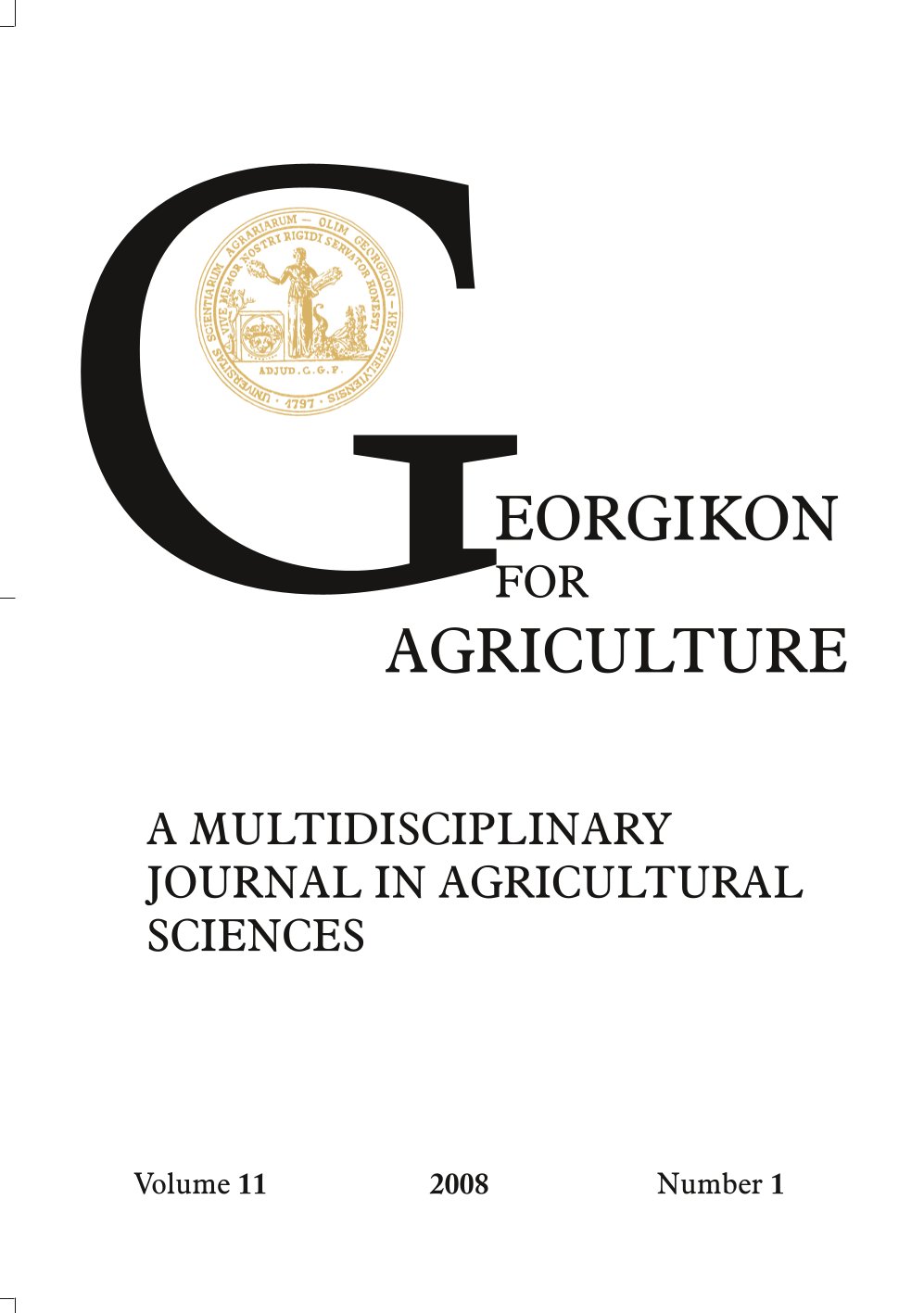Near surface detection of depth-sourced saline water, Duna-Tisza Interfluve
Kulcsszavak:
szikesedés, geofizikai felmérés, vizes élőhelyAbsztrakt
A Duna-Tisza köze területe, és elsősorban a Duna-völgy a szikesedés által erősen érintett terület, ami nagy problémát jelent a mezgazdaság számára. A szikes talajok javítása elengedhetetlen, valamint a Duna-völgy sós vizes élhelyeinek védelme is elsődleges feladat. Ez azonban megköveteli a szikesedés eredetének és a sószállítási mechanizmusoknak ismeretét. A területen végzett hidraulikai feldolgozás kimutatta, hogy a felszín alatti vizeket két hajtóerő tartja mozgásban (Tóth and Almási, 2001). A mély, aljzatból induló túlnyomások és a sekély vizeket hajtó gravitáció. A Duna-völgyben – a hidraulikai feldolgozásunk alapján – a két rendszer egyaránt megcsapolódik a szikes tavak, wetlandek, és szikes talajok zónájában. Feltevésünk szerint a felszíni sós jelenségek a mély eredet, túlnyomásos rendszer magas oldott anyag tartalmú vizének megcsapolódásához köthetek. Kémiai és geofizikai vizsgálatokkal próbáltuk alátámasztani hipotézisünket. A kémiai eredmények ”sós”, nagy oldott anyag tartalmú víz jelenlétét mutatták ki a tó alatt, tőle K-re pedig ”édesvíz” válik uralkodóvá. A geofizikai ellenállásmérések alátámasztották ezt a térbeli eloszlást 100–120 m-es mélységig. Az eredmények együttesen igazolták a mély, sós víz felszín közeli megjelenését és a szikesedés mély, felszín alatti víz eredetét.
Hivatkozások
Balogh, J. 1840. A magyarországi szikes vidékek. Természettudományi pályamunkák. (The Hungarian salt affected areas). A Magyar Tudós Társaság, Buda. 123.
Bosch, F. P., Müller, I. 2005. Contribution to karst groundwater vulnerability mapping by VLF-Gradient survey: Comparison with other geophysical methods. Near Surface Geophysics. 2005. 299–310. https://doi.org/10.3997/1873-0604.2005025
Erdélyi, Á. 1989. A Duna-Tisza közi mezozóos képződmények vizeinek vizsgálata (Investigation of the waters of the Mesozoic rocks in the Duna-Tisza Interfluve). Földtani Kutatás. XXXII/4. 49–56.
Erdélyi, M., Gálfi, J. 1988. Subsurface and surface mapping in hydrogeology. John Wiley and Sons, Akadémiai Kiadó, Budapest. 85–91.
Fischer, G., Schnegg, P. A., Peguiron, M., Le Quang, B. V. 1981. An analytic one-dimensional magnetotelluric inversion scheme. Geophysical Journal of the Royal Astronomical Society. 67. 257–278. https://doi.org/10.1111/j.1365-246X.1981.tb02749.x
Kovács, Gy. 1960. A szikesedés és a talajvízháztartás kapcsolata. (The relation between salinization and groundwater regime). Hidrológiai Közlöny. 40 (2) 131–139.
Kuti, L. 1977. Az agrogeológiai problémák és a talajvíz kapcsolata az Izsáki térképlap területén. (Relation between agrogeological problems and groundwater in zone of Izsák). Magyar Állami Földtani Intézet Évi Jelentése. 1977. 121–130.
Mádlné Szőnyi, J., Simon, Sz., Tóth, J., Pogácsás, Gy. 2005. Felszíni és felszín alatti vizek kapcsolata a Duna-Tisza közi Kelemen-szék és Kolon-tó esetében. (Interrelationship between surface and subsurface waters at the Kelemen-szék and Kolon lakes, Duna-Tisza Interfluve, Hungary). Általános Földtani Szemle (General Geological Review). 30. 93–110.
Mádlné Szőnyi, J., Tóth, J. 2007. The Duna-Tisza Interfluve Hydrogeological Type Section, Hungary. Hydrology Journal, submitted.
Molnár, B., Murvai, I. 1976. A Kiskunsági Nemzeti Park fülöpházi szikes tavainak kialakulása és földtani története. (The origin and geological evolution of the lakes near Fülöpháza, Kiskunság National Park). Hidrológiai Közlöny 2. 67–77.
Müller, I. 1982 Premières prospections électromagnétiques VLF (very low frequency) dans le karst en Suisse. Proceed. of the 7e congrès national de spéléologie, Schwyz, 173–181.
Sigmond, E. 1923. A hidrológiai viszonyok szerepe a szikesek képződésében. (Role of the hydrogeological features in the salinization). Hidrológiai Közlöny. 3 (1) 5–9.
Stiefelhageln, W. 1998. Radio Frequency Elektromagnetics (RF-EM): Kontinuirliche messendes Breitband-VLF, erweitert auf hidrogeologische Problemstellungen. [in Switzerland]. PhD, Nat. Fakt. der Univ. Neuchâtel, Switzerland, 20–31.
Tessedik, S. 1804. A tiszavidéki szikes földek műveléséről, hasznosításáról. (The utilization and cultivation of the saline areas in the Tisza area, Hungary). Patriotisches Wochenblacht für Ungarn. 27. 6.
Tóth, J., Almási, I. 2001 Interpretation of observed fluid potential patterns in a deep sedimentary basin under tectonic compression: Hungarian Great Plain, Pannonian Basin. Geofluids. 1. 11–36. https://doi.org/10.1046/j.1468-8123.2001.11004.x
Turberg, P., Müller, I., Flury, F. 1994. Hydrogeological investigation of porosus environments by radio magnetotelluric-resistivity (RMT-R 12-240 kHz). Journal of Applied Geophysics. 31. 133–143. https://doi.org/10.1016/0926-9851(94)90052-3
Várallyay, Gy. 1967. A dunavölgyi talajok sófelhalmozódási folyamatai. (Salinization processes of the Duna-valley soils). Agrokémia- és Talajtan, 16 (3) 327–349.
Letöltések
Megjelent
Folyóirat szám
Rovat
License
Copyright (c) 2008 Simon Szilvia, Müller Imre

This work is licensed under a Creative Commons Attribution-NonCommercial-NoDerivatives 4.0 International License.
The articel is under the Creative Commons 4.0 standard licenc: CC-BY-NC-ND-4.0. Under the following terms: You must give appropriate credit, provide a link to the license, and indicate if changes were made. You may do so in any reasonable manner, but not in any way that suggests the licensor endorses you or your use. You may not use the material for commercial purposes. If you remix, transform, or build upon the material, you may not distribute the modified material. You may not apply legal terms or technological measures that legally restrict others from doing anything the license permits.




 Georgikon for Agriculture
Georgikon for Agriculture